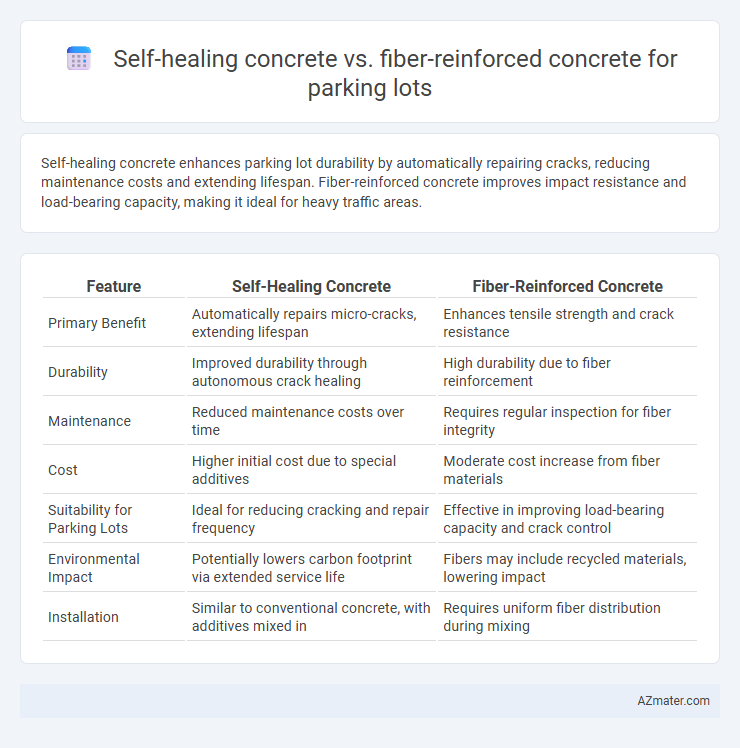Self-healing concrete enhances parking lot durability by automatically repairing cracks, reducing maintenance costs and extending lifespan. Fiber-reinforced concrete improves impact resistance and load-bearing capacity, making it ideal for heavy traffic areas.
Table of Comparison
| Feature | Self-Healing Concrete | Fiber-Reinforced Concrete |
|---|---|---|
| Primary Benefit | Automatically repairs micro-cracks, extending lifespan | Enhances tensile strength and crack resistance |
| Durability | Improved durability through autonomous crack healing | High durability due to fiber reinforcement |
| Maintenance | Reduced maintenance costs over time | Requires regular inspection for fiber integrity |
| Cost | Higher initial cost due to special additives | Moderate cost increase from fiber materials |
| Suitability for Parking Lots | Ideal for reducing cracking and repair frequency | Effective in improving load-bearing capacity and crack control |
| Environmental Impact | Potentially lowers carbon footprint via extended service life | Fibers may include recycled materials, lowering impact |
| Installation | Similar to conventional concrete, with additives mixed in | Requires uniform fiber distribution during mixing |
Introduction to Advanced Concrete Technologies
Self-healing concrete incorporates microcapsules or bacteria that activate upon crack formation, enabling automatic repair and enhancing durability in parking lots by reducing maintenance costs. Fiber-reinforced concrete integrates synthetic or steel fibers to improve tensile strength and crack resistance, offering improved structural integrity under repetitive vehicular loads. Both advanced concrete technologies significantly extend the service life of parking structures by addressing common deterioration mechanisms unique to high-traffic environments.
Overview of Self-Healing Concrete
Self-healing concrete incorporates microcapsules or bacteria that activate to repair cracks autonomously, enhancing durability and reducing maintenance in parking lots. This innovative material extends service life by sealing fissures caused by environmental stress and mechanical loads, preventing water infiltration and corrosion of reinforcement. Its application in parking areas leads to cost savings and improved structural integrity compared to traditional fiber-reinforced concrete, which relies primarily on physical reinforcement to withstand stresses.
What is Fiber-Reinforced Concrete?
Fiber-reinforced concrete (FRC) is a composite material that incorporates fibrous substances such as steel, glass, or synthetic fibers to enhance its structural integrity and durability in parking lot applications. FRC improves resistance to cracking, impact, and shrinkage, resulting in longer-lasting surfaces capable of withstanding heavy vehicular loads. This advanced concrete variant offers superior tensile strength and better fatigue resistance compared to traditional concrete, making it ideal for the high-stress environment of parking lots.
Key Differences Between Self-Healing and Fiber-Reinforced Concrete
Self-healing concrete incorporates bacteria or microcapsules that activate to fill cracks autonomously, significantly reducing maintenance and extending the lifespan of parking lot pavements. Fiber-reinforced concrete enhances structural integrity by incorporating synthetic or steel fibers, improving tensile strength and resistance to cracking under heavy vehicle loads. While self-healing concrete focuses on automatic crack repair and durability, fiber-reinforced concrete primarily aims to prevent crack initiation and improve load-bearing capacity.
Durability of Self-Healing vs Fiber-Reinforced Concrete in Parking Lots
Self-healing concrete offers enhanced durability in parking lots by autonomously repairing microcracks, reducing maintenance frequency and extending service life under heavy vehicular loads. Fiber-reinforced concrete improves toughness and resistance to cracking through the distribution of synthetic or steel fibers, providing increased structural integrity but may still require repair for microcracks. The superior ability of self-healing concrete to seal cracks and prevent ingress of water and chlorides makes it more durable in harsh environmental conditions typical of parking lot surfaces.
Cost Comparison and Long-Term Value
Self-healing concrete reduces maintenance costs over time by autonomously repairing micro-cracks, extending the parking lot's lifespan and minimizing repair frequency. Fiber-reinforced concrete offers enhanced immediate durability and impact resistance but can incur higher upfront material costs without the autonomous repair benefits. Evaluating total cost of ownership, self-healing concrete delivers superior long-term value through decreased upkeep expenses and prolonged structural integrity in parking lot applications.
Maintenance Requirements for Both Concrete Types
Self-healing concrete significantly reduces maintenance requirements in parking lots by autonomously repairing microcracks through embedded bacteria or chemical agents, minimizing water infiltration and freeze-thaw damage. Fiber-reinforced concrete enhances durability by improving tensile strength and crack resistance, but still requires periodic inspections and repairs to address larger cracks or surface wear. Overall, self-healing concrete presents a more cost-effective solution for long-term maintenance compared to fiber-reinforced concrete, which demands more frequent upkeep to maintain structural integrity.
Environmental Impact and Sustainability
Self-healing concrete reduces maintenance frequency and extends pavement lifespan by autonomously sealing cracks, significantly lowering carbon emissions associated with repairs and raw material extraction in parking lots. Fiber-reinforced concrete enhances tensile strength and durability, minimizing surface degradation but may involve synthetic fibers that pose recycling challenges and environmental concerns. Evaluating sustainability, self-healing concrete offers superior environmental benefits through decreased resource consumption, while fiber-reinforced concrete provides immediate performance improvements with moderate ecological trade-offs.
Case Studies: Real-World Parking Lot Applications
Self-healing concrete demonstrated significant durability improvements in the parking lot project at Eindhoven Airport, reducing crack width by 85% within six months, leading to lower maintenance costs and extended service life. Fiber-reinforced concrete was successfully utilized in the Denver International Airport parking structure, where its enhanced tensile strength and resistance to freeze-thaw cycles prevented early deterioration, improving load-bearing capacity and minimizing repair frequency. Both materials proved effective in real-world applications, with self-healing concrete offering autonomous crack closure while fiber-reinforced concrete provides immediate structural reinforcement under heavy traffic conditions.
Choosing the Best Concrete Solution for Your Parking Lot
Self-healing concrete offers superior crack repair capabilities, significantly extending the lifespan of parking lots by autonomously sealing microcracks and preventing water infiltration. Fiber-reinforced concrete enhances structural integrity and resistance to heavy loads, making it ideal for high-traffic areas where durability is critical. Selecting the best concrete solution depends on balancing long-term maintenance costs with load-bearing requirements, where self-healing concrete minimizes repair frequency and fiber reinforcement provides immediate strength benefits.

Infographic: Self-healing concrete vs Fiber-reinforced concrete for Parking lot
 azmater.com
azmater.com